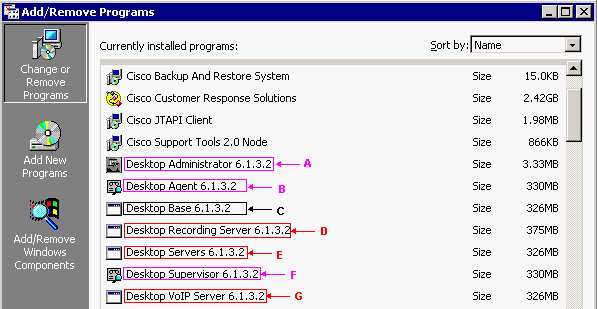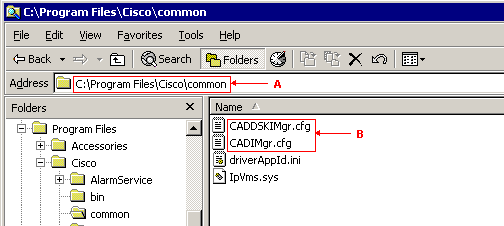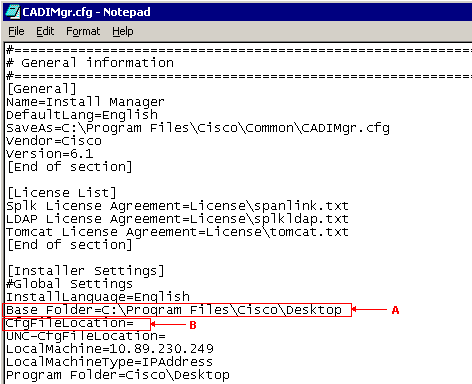Uninstall Cisco Agent Desktop Manually
Available Languages
Contents
Introduction
This document describes the procedure to manually uninstall Cisco Agent Desktop (CAD) in a Cisco IP Contact Center (IPCC) Express environment.
Prerequisites
Requirements
Cisco recommends that you have knowledge of these topics:
-
Cisco IPCC Express
-
CAD
Components Used
The information in this document is based on these software and hardware versions:
-
Cisco IPCC Express version 4.0(x)
-
Cisco Agent Desktop version 6.1(x)
The information in this document was created from the devices in a specific lab environment. All of the devices used in this document started with a cleared (default) configuration. If your network is live, make sure that you understand the potential impact of any command.
Conventions
Refer to Cisco Technical Tips Conventions for more information on document conventions.
Uninstall Cisco Agent Desktop Manually
Complete these steps in order to manually remove the CAD components:
-
From the Windows task bar, choose Start > Settings > Control Panel.
The Control Panel appears.
-
Double-click Add/Remove Programs.
The Add/Remove Properties dialog box appears.
-
It is recommended that you remove the Cisco Desktop Applications in this order:
-
The user applications, such as Desktop Administrator, Desktop Agent, and Desktop Supervisor (see arrows A, B, F in Figure 1).
-
The servers, such as Desktop Recording Server, Desktop Servers, and Desktop VoIP Server (see arrows D, E, G in Figure 1).
-
The Desktop Base (see arrow C in Figure 1).

Note: In the process of removing the application, the system might prompt you to reboot the system. It is recommended that you do reboot the system in order to remove all Cisco Desktop files completely.
-
-
Choose Start > Control Panel > Add/Remove Programs in order to access the Windows Add/Remove Programs dialog box.
If you find any Cisco Desktop application names in the list of programs installed on the computer, search for them (without the version number) under the HKEY_ LOCAL_MACHINE\SYSTEM\CurrentControlSet\Services registry location and delete them.
-
Delete these registry keys:
-
Under HKEY_LOCAL_MACHINE\SOFTWARE, delete this key:
Spanlink
-
Under HKEY_LOCAL_MACHINE\SOFTWARE\ODBC\ODBC.INI, delete these keys:
FCRasSvrDB FCVoIP FCVoIP_sub_1 FCVoIP_sub_2 FCVoIP_sub_3 FCVoIP_sub_4 SYNC_SERVER_A SYNC_SERVER_B
-
Under HKEY_LOCAL_MACHINE\SOFTWARE\Microsoft\Windows\ CurrentVersion\Uninstall, delete these keys:
{1F99B160-BDCE-11D5-84FE-0001031A6A35} (base) {2A879B13-E744-11D4-849E-0001031A6A35} (footprint) {2DF142C0-11F6-11D4-8770-00105AA752A8} (dir serv) {3AFB74C0-527B-11D4-8776-00105AA752A8} (enterprise) {3E2F65E8-7773-11D4-8466-0001031C0C0B} (chat) {3F2EEAA1-1F49-11D4-8770-00105AA752A8} (voip) {4FE45CA0-9E24-11D5-84F4-0001031A6A35} (rascal) {536A8CD0-F07E-11D4-849F-0001031A6A35} (telecaster) {671EAD40-79FA-11D5-84E8-0001031A6A35} (serv create) {7816039C-78FE-11D4-8466-0001031C0C0B} (admin) {AEF488C0-5B62-11D5-84E0-0001031A6A35} (doc) {B2C70A61-0941-11D4-8770-00105AA752A8} (agent) {BF7D7545-3373-11D5-84D1-0001031A6A35} (supervisor) {FD3E6760-4B71-11D4-8773-00105AA752A8} (media term) -
Under HKEY_LOCAL_MACHINE\SYSTEM\CurrentControlSet\Services, delete these keys:
FastCall Chat Server RASCALServer Spanlink Spanlink FastCall Enterprise Server splkldap splkldapmon SyncServer TAIServer VoIPMonitorServer
-
If Desktop Servers were installed on their own box (not coresident), delete these keys:
MSSQLServer SQLServerAgent Tomcat
-
-
In the C:\Program Files\Cisco\common folder, open all files with the suffix Mgr.cfg, such as CADDSKIMgr.cfg and CADIMgr.cfg (see arrow B in Figure 2).
Figure 2: \Program Files\Cisco\common
For example, complete these in CADIMgr.cfg:
-
Delete the network configuration folder pointed by CfgFileLocation (see arrow B in Figure 3) if there is one.
-
Identify the base folder by the Base Folder parameter (see arrow A in Figure 3) in the same section.

-
-
Delete these folders and their contents:
-
C:\Program Files\Cisco\Desktop
-
C:\Program Files\Cisco\IM
-
C:\Program Files\Spanlink
-
C:\Program Files\Cisco\Desktop_Cfg
-
C:\Program Files\Cisco\AudioFiles
-
-
Under the C:\Program Files\Installshield Installation Information folder, delete these folders:
{1F99B160-BDCE-11D5-84FE-0001031A6A35} (base) {2A879B13-E744-11D4-849E-0001031A6A35} (footprint) {2DF142C0-11F6-11D4-8770-00105AA752A8} (dir serv) {3AFB74C0-527B-11D4-8776-00105AA752A8} (enterprise) {3E2F65E8-7773-11D4-8466-0001031C0C0B} (chat) {3F2EEAA1-1F49-11D4-8770-00105AA752A8} (voip) {4FE45CA0-9E24-11D5-84F4-0001031A6A35} (rascal) {536A8CD0-F07E-11D4-849F-0001031A6A35} (telecaster) {671EAD40-79FA-11D5-84E8-0001031A6A35} (serv create) {7816039C-78FE-11D4-8466-0001031C0C0B} (admin) {AEF488C0-5B62-11D5-84E0-0001031A6A35} (doc) {B2C70A61-0941-11D4-8770-00105AA752A8} (agent) {BF7D7545-3373-11D5-84D1-0001031A6A35} (supervisor) {FD3E6760-4B71-11D4-8773-00105AA752A8} (media term) -
Reboot the computer before you attempt to reinstall any Cisco Desktop applications.
Related Information
Contact Cisco
- Open a Support Case

- (Requires a Cisco Service Contract)



 Feedback
Feedback